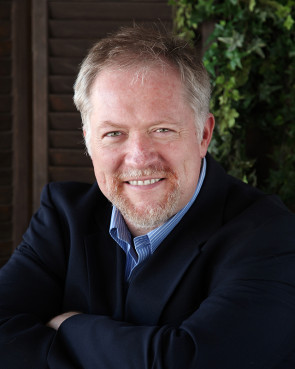Walking through the streets of 1st century Nazareth and crossing the Red Sea with the Israelites will be part of the immersive visitor experience in the planned Museum of the Bible in Washington DC.
“There will be a mix between performance and film by a company that usually works for Pixar or Disney,” says David Trobisch, the collections director of the museum set to open at the end of 2017.
“So it’s like in a theme park where everyone dresses up in costume and everything that’s there is really from the period and you can talk to the people.
“You’ll have a screen in the background but then a live actor steps in and talks to Herod the Great. Also there is a section that’s the life and times of Jesus.”
In its first year, the museum, which at present is just a hole in the ground about three blocks from the Capitol in Washington, needs to attract two million visitors to be viable.
With $US400 million spent on the building alone, the total project will cost close to $US1 billion, all of which is being raised through private donations.
“It will be spectacular,” says Allen Quine, the museum’s vice-president of International Affairs.
“In the end it will be 16 storeys high but only eight storeys because each floor will be two storeys. So you walk in the front door and the idea is you will be just completely awed. The ceiling of the first floor will be LCD panels that will have paintings and scrolls and manuscripts being displayed and rotating so that a person from the beginning is just tremendously overwhelmed.”
As a the son of Lutheran missionaries, David Trobisch would prefer the opening date of the Museum of the Bible to be 31 October 2017, the 500th anniversary of the Reformation.
However, when the giant 40,000-square-metre building does open on 30 November 2017, he hopes it will have cast off any lingering criticism that it is evangelical propaganda telling a narrow Protestant story of the Bible.
Since coming on board two years ago, the prominent liberal academic with dual German and US citizenship has not only boosted the museum’s scholarly credentials but also broadened the museum’s scope to reflect the diversity of the Christian movement.
The majority of the exhibits will still be sifted from the massive biblical antiquities collection of the conservative evangelical Green family, owners of the Hobby Lobby chain of craft stores, which was the catalyst for the museum.
But there will also be collections from the Vatican Museum, the Vatican Library and the prestigious Israel Antiquities Authority, among others.
One floor will display about 1200 artefacts including a Gilgamesh tablet, several fragments of the Dead Sea Scrolls, a collection of Jewish texts and scrolls and a microfiche of a Bible that went to the Moon.
“It started with the Green collection but we also have other collections and at the moment we’re negotiating with the Bible Society to take their collection of printed Bibles – we will just curate them, we will never own them,” Dr Trobisch told Eternity on a flying visit to Sydney.
“We bought a 7000-volume library in Israel, all in modern Hebrew but mostly from the 19th and 20th centuries, so we not only have a collection of rare books but we’re also starting to have a library working together with the universities.”
While the collection is strong in Western Bible artefacts, the well-connected Dr Trobisch is continuing to make acquisitions in the hope of filling a lot of international “white spots”.
“Eastern Christianity is not very well documented,” says Dr Trobisch, who has worked with a variety of institutions as a biblical manuscript scholar and research consultant.
“Just last month I bought the first edition of the Russian Bible in Georgia and that was a big step – we would like to see more of them.
“We are planning to go to Moscow soon for an exploratory visit and have invitations there from dealers and collectors and private institutions. This is really important.”
Having been born and raised in Cameroon in West Africa, Dr Trobisch also has a heart to see “the forgotten continent” represented.
“Percentage-wise many more Cameroonians go to church every Sunday than in any Western country including the US,” he says.
“We would also like their voice to be heard and the history and impact of the Bible on countries we may not even know exist.”
Dr Trobisch had flown into Australia from India, where he was looking at the William Carey archives with a view to telling the story of the first protestant missions to India, while his colleagues were exploring possibilities in Singapore and Seoul.
Contrary to scholars’ fears about the motives of the museum, both Dr Trobisch and Mr Quine insist that its mission is simply to engage people with the Bible and let them make up their own minds about it.
They say it is Hobby Lobby president Steve Green, who amassed the 44,000-item antiquities collection over just six years from 2009, who has been driving the museum in this direction.
“I was hired with a clear job description to make sure that everything is done to the highest scholarly standards,” says Dr Trobisch.
“So we now have about 20 people working on the collection, including seven PhDs, so our cuneiform specialist will ensure that the cuneiform thing is done right and our medieval manuscript person will be in charge of that.
My role is as a conductor… I make sure that it comes together and works well.
“With the acquisitions, what I have tried to change is, instead of getting a lot of them, to buy fewer but of a much higher grade.”
One of the tricky issues Dr Trobisch has had to deal with is the questionable provenance of some of the items that were bought by Steve Green in bulk.
“In the early history of the collection, the documentation isn’t what you wish it would be. When you buy in bulk, you don’t really know how many items were in that box or what exactly they were, and they haven’t quite followed up.”
The item that has caused him most grief is a papyrus fragment of the Book of Galations, which reportedly was offered for sale on eBay in 2012, and was the subject of a critical article in The Atlantic.
“We got it from Christie’s and so the journalist assumed that Christie’s lied to us, and I don’t know what to do because there’s nothing in the world I can do but take the provenance letters that we received and I trust them.
“I’m sure you’ve encountered people who just have a prejudice. But it comes from both sides. The scholars criticise us – they’re afraid we’re an evangelical mission society, and the very conservative faith communities are afraid we’re scholars. So you can’t please everyone.”
Email This Story
Why not send this to a friend?





